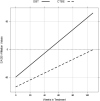Treatment differences in the therapeutic relationship and introject during a 2-year randomized controlled trial of dialectical behavior therapy versus nonbehavioral psychotherapy experts for borderline personality disorder
- PMID: 22061867
- PMCID: PMC3265694
- DOI: 10.1037/a0026113
Treatment differences in the therapeutic relationship and introject during a 2-year randomized controlled trial of dialectical behavior therapy versus nonbehavioral psychotherapy experts for borderline personality disorder
Abstract
Objective: The present study explored the role of the therapeutic relationship and introject during the course of dialectical behavior therapy (DBT; Linehan, 1993) for the treatment of borderline personality disorder.
Method: Women meeting DSM-IV criteria for borderline personality disorder (N = 101) were randomized to receive DBT or community treatment by experts. The Structural Analysis of Social Behavior (Benjamin, 1974) was used to measure both the therapeutic relationship and introject.
Results: Relative to community treatment by experts, DBT participants reported the development of a more positive introject, including significantly greater self-affirmation, self-love, self-protection, and less self-attack, during the course of treatment and 1-year follow-up. The therapeutic relationship did not have an independent effect on intrapsychic or symptomatic outcome but did interact with treatment. DBT participants who perceived their therapist as affirming and protecting reported less frequent occurrences of nonsuicidal self-injury.
Conclusions: The study showed positive intrapsychic change during DBT and emphasized the importance of affirmation and control in the therapeutic relationship. Results are discussed in the context of understanding the mechanisms of change in DBT.
(PsycINFO Database Record (c) 2012 APA, all rights reserved).
Figures





References
-
- American Psychiatric Association . Diagnostic and Statistical Manual of Mental disorders. 4th Ed. American Psychiatric Association; Washington, D.C.: 1994.
-
- Atkins DC, Gallop RJ. Rethinking how family researchers model infrequent outcomes: A tutorial on count regression and zero-inflated models. Journal of Family Psychology. 2007;21:726–735. - PubMed
-
- Beck AT, Ward CH, Mendelson M, Mock J, Erbaugh J. An inventory for measuring depression. Archives of General Psychiatry. 1961;4:561–571. - PubMed
-
- Benjamin LS. Structural analysis of social behavior. Psychological Review. 1974;81:393–425.
-
- Benjamin LS. The INTREX user's manual, Part I and II. Intrex Interpersonal Institute, Inc., P.O. Box 55218, Madison, WI 53705; Madison, WI: 1983.

